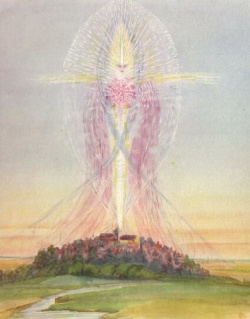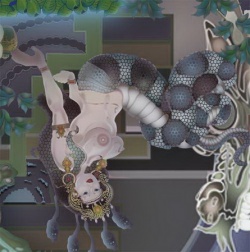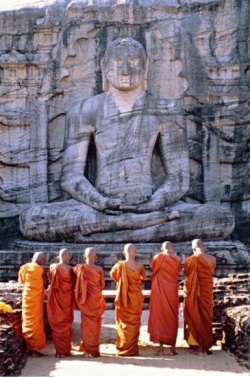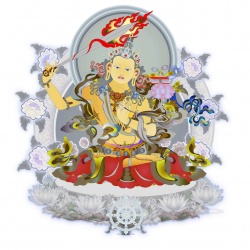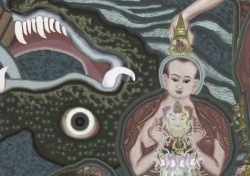On Lokayata Philosophy
Rhys Davids
(From the introduction to the English translation of the Kutadanta Sutta; Dialogues of the Buddha - page 166-172, London, 1889)
There is a curious expression in the stock phrase describing the learned Brahman, so often found in the Piṭakas, which I have left untranslated in this Sutta, being uncertain as to the meaning in which it was used at the time when our Sutta was composed. It will be instructive, in more ways than one, to collect and consider the other passages in which the word occurs.
Lokāyata is explained by Wilson as `the system of atheistical philosophy taught by Cārvāka,1 and by the Petersburg Dictionary as `Materialism'. Now the description of the good Brahman as put, in the Buddhist Suttas, into the mouth of Brahmans themselves,2 mentions Lokāyata as one branch of his learning. The whole paragraph is complimentary. And though the exact connotation of one or two of the other terms is doubtful, they are all descriptive of just those things which a Brahman would have been rightly proud to be judged a master of. It is evident, therefore, that the Dictionary interpretations of the word are quite out of place in this connection.
Yet they are each of them, at least for a later period, well authenticated. Kumārila Bhaṭṭa, in his Vārttika (verse 10), charges the Mīmāṃsā system with having been, for the most part, converted into a Lokāyata system, and claims for his own book the merit of bringing it back to theistic lines.3 Now of course the Mīmāṃsists would indignantly deny this. Kumārila, who seems to have been a good deal of a bigot, is here merely hurling at adversaries, who claimed to be as orthodox as himself, a term of abuse. But it is clear that he uses that term in the sense of `atheistic.' The exact phrase would be nāstika, as opposed to his own āstika-patha: that is, the system or the man who says `there is not,' an infidel. This is somewhat wider than atheist; it comes however, in Kumārila's mouth, to much the same thing.
Saṅkarācārya uses the word lokāyata several times, 4 and always in the same specific sense as the view of those who look upon the soul as identical with the body, as existing only so long as the body exists, not continuing, after death, in a new condition and separate from the body. A very similar, if not indeed the very same view is also controverted in the Brahmajāla Sutta (above, P. 46); and is constantly referred to throughout the Piṭakas under the stock phrase taṃ jīvaṃ taṃ sarīraṃ.5 But it is never called Lokāyata in the Piṭakas. It seems to be the view that there is a soul; but that it is diffused through the body, and dies with it; and is not a separate unity, within the body but not of it, which flies away from the body after death. It is not necessary to suppose that either. Saṅkara or the Buddhists had in their minds any book setting forth a philosophy based on this single proposition, or any actual school using such a book as a manual. It may have been so. But the expressions used point rather to an opinion held by certain thinkers, in union with other opinions, and not expounded in any special treatise. Nor do either the Buddhists or úaṅkara pretend to set out that opinion in full. They are dealing with it only so far as is necessary to enforce their own contrary positions. And though `materialist,' as a rough and ready translation of. Saṅkara's Lokāyatika, gives a good idea, to a European reader, of the sort of feeling conveyed to Saṅkara's Indian readers, yet it is not quite exact. European `materialists' (and one or two may be discovered by careful search) do not hold the view which úaṅkara describes to his Lokāyatikas.
Buddhaghosa in our passage has: Lokāyataṃ vuccati vitaṇḍa-vāda-satthaṃ, `the Lokāyata is a text-book of the Vitaṇḍas (Sophists) 6 This does not help us much; but previously, p. 91, he explains Lokakkhāyikā as follows: `Foolish talk according to the Lokāyata, that is the Vitaṇḍa, such as: “By whom was this world created? By such a one. A crow is white from the whiteness of its bones; cranes are red from the redness of their blood.”
Other Pāli comments on the word are the Abhidhāna Padīpikā (verse 112), which says simply, probably following Buddhaghosa: Vitaṇḍa-satthaṃ viññeyyaṃ yaṃ taṃ lokāyataṃ. The date of this work is, the middle of the twelfth century A. D. Much clearer is Aggavaṃsa in the Sadda-nīti, which is a generation older. He says: 7
Loko ti bāla-loko; ettha āyatanti ussāhanti vāyamanti vādassādenāti lokāyataṃ. Ayatati vā tena loko, na yatati na īhati vā, lokāyataṃ. Taṃ hi gandhaṃ nissāya sattā puñña-kiriyāya. kittaṃ na uppadenti. Lokāyataṃ. nāma: sabbaṃ Ucchiṭṭhaṃ sabbaṃ anucchiṭṭhaṃ seto kāko kāḷo bako iminā va iminā va kāranenāti evam-ādi-niratthaka-karaṃa-paṭisaṃyuttaṃ titthiya-satthaṃ, yaṃ loke Vitaṇḍasatthaṃ vuccati, yaṃ sandhāya Bodhisatto asamadhuro Vidhūra-paṇḍito:
Na seve Lokāyatikaṃ, n'etaṃ puññāya vaḍḍhanaṃ ti āha.
`Loko means the common world. Lokāyata means: “on that they āyatanti;” that is, they exert themselves about it, strive about it, through the pleasure they take in discussion. Or perhaps it means: “the world does not yatati by it”; that is, does not depend on it, move on by it. For living beings do not stir up their hearts to right-doing by reason of that book. 8 Now the Lokāyata is the book of the unbelievers (of the Titthiyas) full of such useless disputations as the following: “All is impure; all is not impure; the crow is white, the crane is black; and for this reason or for that”—the book known in the world as the Vitaṇḍa-sattha, of which the Bodisat, the incomparable leader, Vidhūra the pandit, said:
“Follow not the Lokāyata, that works not for progress in merit.”
The verse quoted—certainly a very old one—is in the Vidhūra Jātaka, 9 and the commentator there says: `This means: Follow not Lokāyata disputation, Vitaṇḍa chatter, concerned with useless matters which neither give paradise nor lead men on into the Path.'
Saṅkara says: `There is thus, according to them, no soul, separate from the body, and capable of going to the heavenly world or obtaining release.' 10 The unknown author of the Jātaka commentary, who certainly wrote however in the fifth century, gives the allied proposition as his own conclusion from the uselessness of their discussions, not as the opinion of the Lokāyatikas themselves. It would be an easy transition from the one expression to the other. And the difference is suggestive, especially in the light of other passages in both Sanskrit and Pāli books.
For while the Mahābhārata has precisely the same use of the word as the Piṭakas, later works use it in a manner approximating more and more nearly to that of Saṅkara. The passage in the Mahābhārata is at I, 2889 (= Hari Vaṃsa 14068), where, at the end of a list of the accomplishments of learned Brahmans, they are said to be masters of the Lokāyata. Being mentioned, as in our passage, at the end of the list, it is plain that this branch of learning is meant to be taken as of minor importance. But it is not yet considered unfavourably, much less opprobiously. And the Petersburg Dictionary, from which I take most of these references, points out that the word may possibly, in this passage, have some other meaning than `Materialism.'
The Rāmāyaṇa goes further. There the word is also in a list, but the Laukāyatikā are blamed as `clever in useless things.' 11 So in the Saddharma Puṇḍarīka, the good Mahāyānist does not serve or court or wait upon (among other low people) `the Lokāyatikas who know by heart the Lokāyata mantras (mystic verses).' 12 The date of this may be a century or two after Christ. And in the Gain book, entitled the Bhagavatī, which Weber puts at about the same time, the Lokāyatikas occur in a similar list of blameworthy persons. 13
In the Milinda, which is probably somewhat earlier, the word is mentioned twice. One passage ascribes a knowledge of the Lokāyata (in a sentence expanded from the very clause in our Sutta) to the hero of the story, Nāgasena.14 Here the Milinda is quite at the old standpoint. The other passage is in a parenthesis, 15 in which the sub-hero, the king, is described as `fond of wordy disputations, and in the habit of wrangling against the quibbles of Lokāyatas and Vitaṇḍas.' This may possibly be a gloss which has crept into the text. But in any case it is evidence that, at the time when it was written, the later view of the meaning of the word had become prevalent.
In the long list of various sorts of hermits given in the Harsha Carita the Lokāyatikas come among others who would be classed by Vedāntists as heretics. 16 We cannot, unfortunately, draw any certain conclusion as to whether or not there were actually any Lokāyatikas living in Bāṇa's time. In expanding previous descriptions of the concourse of hermits in the forest, he may be merely including in his list all the sorts of such people he had ever heard or read of.
Lastly, the Lokāyata system is, in various works of the fourteenth century and later, appropriately fathered on Cārvāka, a mythical character in the Mahābhārata, an ogre, who appears in the garb of a Brahman. 17 It is not certain whether this is due to the ingenuity of a friend or a foe. In either case, like the fathering of the later Sāṅkhya on the ancient sage Kapila; or the fathering of the collection of fables, made by Planudes in the fourteenth century A. D., upon Aesop the story-teller of the fifth century B. C., it has been eminently successful, has deceived many, and is still widely accepted.
Pending the discovery of other texts, and especially of such as are not only the testimony of opponents, the best working hypothesis to explain the above facts seems to be that about 500 B. C. the word Lokāyata was used in a complimentary way as the name of a branch of Brahman learning, and probably meant Nature-lore—wise sayings, riddles, rhymes, and theories handed down by tradition as to cosmogony, the elements, the stars, the weather, scraps of astronomy, of elementary physics, even of anatomy, and knowledge of the nature of precious stones, and of birds and beasts and plants. To be a master of such lore was then considered by no means unbecoming to a learned Brahman, though it ranked, of course, below his other studies. At that time there was no school so called, and no special handbook of such knowledge. But portions of it trenched so closely upon, were so often useful as metaphor in discussing the higher and more especially priestly wisdom, that we find sayings that may well have belonged to it preserved in the pre-Buddhistic literature. Such passages, for instance, as Bçi. Ār. Up. III, 8, 3, Chānd. Up. IV, 17, 1, and VI, 2-7, on the worlds and on cosmogony; Chānd. III. on the colour of the rays of the sun; Bçi. Ār. Up. II, 1, 5-7, and III, 7, 3-7, on the elements; Ait. Ār. III, 2, 1, 4, and others, on the parts of the body; and many others of a similar kind on these and other subjects might be cited as examples.
The amount then existing of such lore was too small to make a fair proficiency in it incompatible with other knowledge. As the amount of it grew larger, and several branches of natural science were regularly studied, a too exclusive acquaintance with Lokāyata became looked upon with disfavour. Even before the Christian era masters of the dark sayings, the mysteries, of such mundane lore were marked with sophists and casuists. This feeling is increasingly vouched for in the early centuries of our era. In the fifth century we hear of a book, presumably on the `riddles and mysteries of the craft, as it is called `a book of quibbles.' Various branches of mundane science had been by that time fairly well worked out. Lokāyata was still the name for the old Nature-lore, on the same level as folk-lore, and in contradistinction, not only to theosophy on the one hand, but to such science as there was on the other.
In the first half of the eighth century Kumārila uses the word as a mere term of abuse, and in the sense of infidel of his equally orthodox opponents, the Mīmāṃsists. And shortly afterwards Saṅkara, in setting forth his theory of the soul, controverts a curious opinion which he ascribes to Lokāyatikas—possibly wrongly, as the very same opinion was controverted ages before in the Piṭakas, and not there called Lokāyata, though the word was in use in Piṭaka times.
Finally in the fourteenth century the great theologian Sāyaṇa-Mādhava has a longish chapter in which he ascribes to the Lokāyatikas the most extreme forms of the let-us-eat-and-drink-for-tomorrow-we-die view of life; of Pyrrhonism in philosophy, and of atheism in theology. The Lokāyata had no doubt, at that time, long ceased to exist. His very able description has all the appearance of being drawn from his own imagination; and is chiefly based on certain infidel doggrel verses which cannot possibly have formed a part of the Lokāyata studied by the Brahmans of old. 18 It is the ideal of what will happen to the man of some intellect, but morally so depraved that he will not accept the theosophist position.
Throughout the whole story we have no evidence of any one who called himself a Lokāyatika, or his own knowledge Lokāyata. After the early use of the word in some such sense as Nature-lore, folk-lore, there is a tone of unreality over all the statements we have. And of the real existence of a school of thought, or of a system of philosophy that called itself by the name there is no trace. In the middle period the riddles and quibbles of the Nature-lorists are despised. In the last period the words Lokāyata, Lokāyatika, become mere hobby horses, pegs on which certain writers can hang the views that they impute to their adversaries, and give them, in doing so, an odious name.
NOTES
He gives as his authority, the Amara Koùa; but the Koùa merely mentions the word, in a list, without any explanation.
Aṅguttara I, 163, and other passages.
The passage is quoted in Muir's Sanskrit Texts,' III, 95.
For instance in his commentary on the Brahma-Sūtra, I, 1, 2; II, 2, 2; III, 3, 53.
For instance in the Mahāli and Jāliya Suttas, both translated below.
Sum. I, 247. The Vitaṇḍas are quoted and refuted in the Attha Sālinī, pp. 3, 90, 92, 241 (where the word is wrongly spelt).
Quoted sub voce in Subhūti's `Abbidhānappadīpikā Sūci' p. 310. According to the Sāsana Vaṃsa Dīpikā (Dr. Mabel Bode's edition, p. 74), he lived at Arimaddana in Burma in 1127 A. D. See also Sāsana Vaṃsa Dīpo, verse 1238; Gandha Vaṃsa, pp. 63, 67; Forchammer, `Jardine Prize Essay,' p. 34; J. P. T. S, 1882, p. 103.
With this attempt at derivation may be compared Nīlakaṇṭha on the passage quoted below from the Mahābhārata (as given in B. R.), Loka evāyatante te lokayatikā. Also Prof. Cowell's suggestion (Sarvad. S., p. 2) that Lokāyata may be analysed etymologically as `prevalent in the world.' The exact meaning of āyata is really very doubtful.
Fausb"ll's edition, VI, 286. No less than four bas reliefs, illustrating this Jātaka, have been found at the Bharhut Tope. See my `Buddhist Birth Stories,' p. cii. On the greater age of the verses, as compared with the prose, of the Jātakas, see ibid. lxxviii.
Loc. cit. See Deussen, `Vedānta-system,' 310; and Thibaut, `Vedānta-Sutras,' II, 269.
Gorresio's edition, II, 109, 29. Both these passages from the epics are from later portions of them.
Chapter XIII, at the beginning. Burnouf (p. 168) reads tantras (instead of mantras), no doubt wrongly, and has a curious blunder in his note on the passage (P. 409). He says Lokāyata means in Pāli `fabulous history, romance'; and quotes, as his authority, the passage given above from the Abhidhāna Padīpikā, in which Lokāyataṃ is simply explained as vitaṇḍa-satthaṃ. This last expression cannot possibly mean anything of that sort.
Weber, Ueber ein fragment der Bhagavatī, II, 248.
My Milinda, I, 7.
Ibid. I, 17.
Cowell's Translation, p. 236.
Madhusūdana Sarasvatī, Prabodhacandrodaya, Sarva-darùana saṃgraha.
Sarva-darùana-saṃgraha, Chapter I, translated by Prof. Cowell in the version published in 1882.
